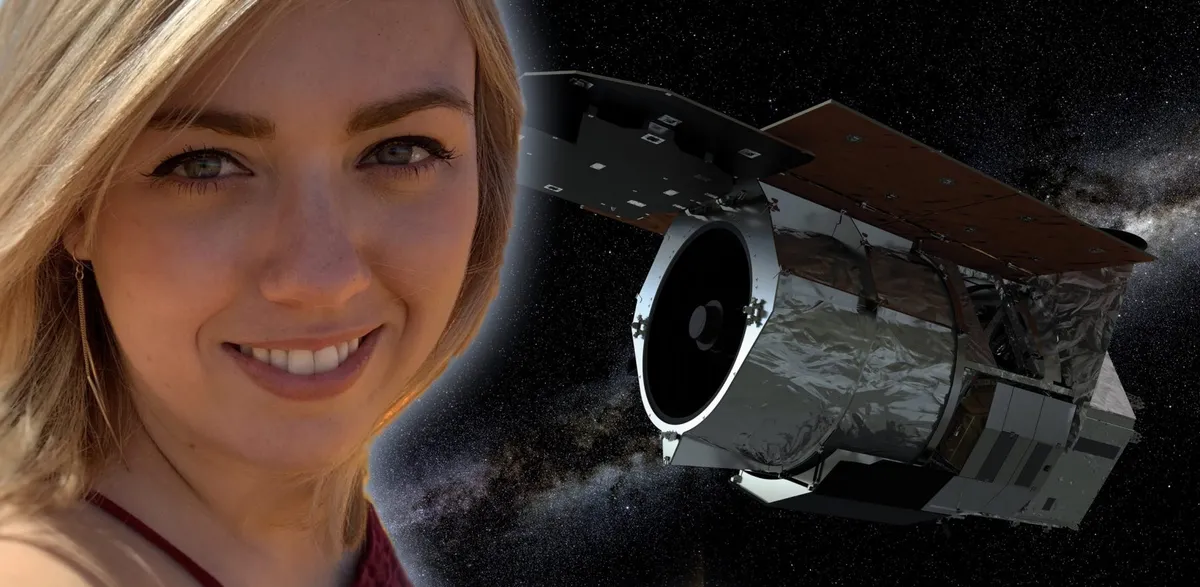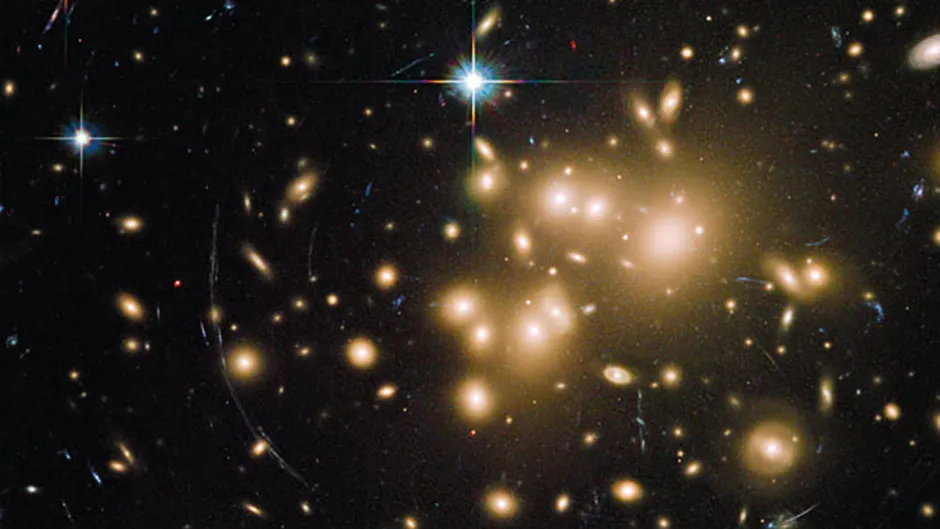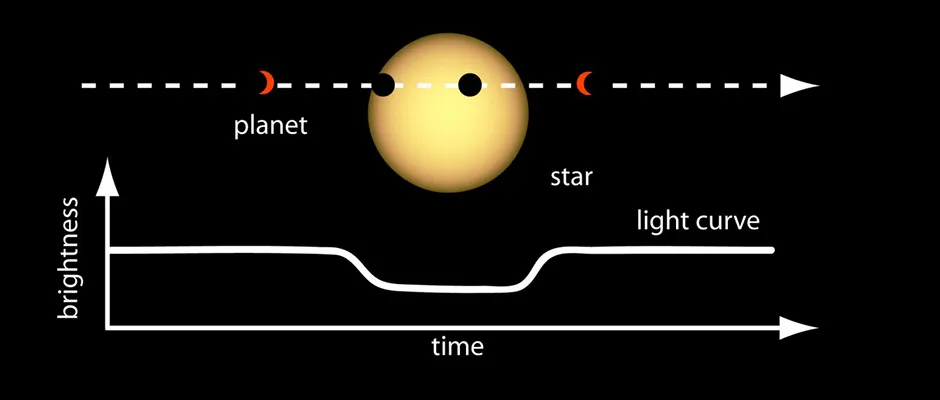The search for planets orbiting distant stars, known as exoplanets, is one of the fastest growing fields in astronomy.
From scorching hot Jupiter-like bodies to huge 'super Earths', exoplanet science has revealed just how diverse the numerous worlds populating our Galaxy can be.
The Nancy Grace Roman Space Telescope (formerly the Wide Field Infrared Survey Telescope (WFIRST)) is one of the newest telescopes joining in the search for exoplanets, and it's going to be using a unique technique to do so.
It has been named after the US astronomer Nancy Grace Roman.
We spoke to astronomer Dr Savannah Jacklin of Vanderbilt University in Nashville, Tennessee to find out about her involvement in the mission, how the Roman Space Telescope is operated and what it might discover.

How can gravity locate exoplanets?
My focus for the past five years or so has been on a type of science called gravitational microlensing, which is a unique and largely understudied way to find new planets outside of our Solar System.
It’s a fairly new concept in terms of scientific discoveries in astronomy. It was first proposed by Einstein in the 1930s, but he thought that while it was physically possible, we would never be able to observe it because there is less than one in a million chance per star, per year, of seeing a microlensing phenomenon.
However, with advances in technology like the CCD camera, for example, we're able to monitor many millions of stars at once.
What had once been impossible - finding these microlensing events - has now become a pretty regular occurrence.
For microlensing to occur, you need three parties.
- You need the observer, which is usually here on Earth, or perhaps a satellite orbiting Earth
- You need a background star at the very centre of our Galaxy
- Between the background star and the observer is what we call the lens system
The lens system is a star that sometimes has a planet around it, and it passes between the background star and the observer on Earth
As it passes in between it acts like a giant magnifying glass in space: it magnifies the light from the background star as it's viewed by the observer on Earth.
When that happens, the background star appears to get up to 1,000 times brighter than it's supposed to be.
And different variations in that brightness - which appear in our data in the form of bumps and wiggles - can indicate whether there is a planet also orbiting that lens star.
Is microlensing similar to gravitational lensing?
It's pretty much the same concept. Gravitational lensing exists on the macro scale when we’re talking about galaxies, but microlensing does exist.
As of right now, we're really only able to see it within our own Galaxy and we need very sensitive instruments that are unwavering in their observations of stars.
They have to look all of the time or almost all of the time. They need to take many pictures that have a high cadence over time in order to find these events.
That's something that's different from macrolensing, which is very long scale.
Microlensing is on a much shorter timescale: anywhere from 1 hour to maybe 45 days or so for a planetary event to be occurring.

How will the Nancy Grace RomanSpace Telescope study exoplanets?
The Nancy Grace RomanSpaceTelescope is a really incredible space mission that’s primarily being developed by NASA. It’s supposed to be launched in the mid 2020s and it's like a successor to the Hubble Space Telescope and the James Webb Space Telescope, except it's looking specifically in the infrared.
We look in the infrared when we’re doing microlensing because we're looking at the centre of our Galaxy, and the centre of our Galaxy is obscured by a lot of dust.
Infrared light has a very special and unique property such that it's actually able to see through that dust and see much further than the regular visible light that our eyes see.
Microlensing is an unusual technique. It's a fairly small field. There are only a couple hundred of us in the world.
And when we launch our observatory into space, we don't have to deal with the infrared light from our atmosphere that often obscures our observations, just like the dust does at the centre of the Galaxy.
Doing this from space allows us to see a lot further and a lot better, but until now there has been no dedicated space microlensing mission.
The Roman Space Telescope will be pointing its telescope lens at the specific area of the sky that we need for microlensing in a dedicated way for a large portion of its mission. And we're very excited about that.
What will the Roman Space Telescope see and how will its data be used?
What we're looking for is something called a light curve for the star, which is looking at the magnitude or brightness of light over time.
When you have a microlensing event that just involves a star without a planet, the light curve looks like an upside-down bell shape curve.
When you have an exoplanet that is also associated with that lens star, the shape of that curve is altered.
You can see big spikes that are associated with the planet that sometimes look a little bit like an Eye of Sauron. Other times it just looks really crazy all together.
But if you know there's a microlensing event, you expect to see this very characteristic shape of light curve.
And if you see any deviations from that specific shape of light curve, you know that you want to investigate it further.
By applying various techniques using pretty advanced software that's being developed right now, we're able to figure out some of the characteristics of a planet that might be indicated by those bumps and wiggles.

We already have methods of detecting exoplanets. Why use microlensing?
Microlensing is exploring a really different area of parameter space. It finds different types of planets than transits or radial velocity methods are able to find.
Microlensing is sensitive to planets that are just beyond the snow line: about the area around its star where Mars is in our Solar System. And it's also very good at finding low mass planets.
One of the things that we learned from transit surveys, for example, is that there are a decent amount of what we call ‘hot Jupiters’ out there.
These are really big exoplanets that are orbiting very close to their host stars. Sometimes their years can be four Earth days long.
As we launch new telescopes into space and build great new observatories...they're going to completely shift our view of the Universe.
Microlensing can find actual analogues to our Solar System, so it can find small planets that are far from their stars like Earth, or Mars.
And it can even find more exotic planets: the types of things that we don't see in our Solar System.
So a lot of what we do with microlensing is trying to understand the ‘zoo’ of planets that exists within our Galaxy.
We’re trying to see if there are really other Earths and Mars-like exoplanets out there and hopefully eventually move on to characterise them.
Will it help search for life beyond the Solar System?
I believe so. A lot of times we're looking for life as we know it. That means usually the biggest indicator is whether liquid water can exist on the surface of an exoplanet.
And we know that for that to occur, it needs to be somewhere around the snow line or preferably inwards of the snow line, such that you can find liquid water on the surface.
Because microlensing is sensitive to that, when the Nancy Grace Roman Space Telescope finds many new exoplanets we'll be able to determine the probability of finding an ‘Earth-like’ planet.
If we can figure out how many planets can host life, then maybe we can re-evaluate what our expectations are for finding life elsewhere in our Galaxy.
You work with the UK Infrared Telescope. Is that a pathfinder mission for the Roman Space Telescope?
Yes, that is pretty much what we call our survey. We've been using UKIRT from 2015 onwards, and what we've been doing is a precursor survey for the Roman.
In the past, most microlensing observations have been in optical wavelengths: the light that we see with our eyes.
That's great and we've discovered a lot, but in order to find the most number of microlensing events for the fewest number of hours of observations you need to look at really crowded areas of sky.
These are areas where those three objects - the source, the lens and the observer - are most likely to line up.
The most crowded area of our sky is the galactic centre. And because there’s a lot of dust there, you can't see through it if you're using those optical wavelengths.
UKIRT is the first infrared ground-based microlensing survey that has actually looked into trying to map out the probability of microlensing events at our galactic centre. And the reason we're doing that is because we want to maximise what the Nancy Grace RomanSpaceTelescope will see.
We're trying to help inform the field locations where we’ll point the Roman Space Telescope to maximise its science such that we can find the most number of exoplanets.

Did you always want to do microlensing?
Microlensing is actually something I didn't learn about until I entered grad school. And it because it's a bit of an unusual technique for finding exoplanets, it's a fairly small field. There are only a couple hundred of us in the world.
As a graduate student, I found a group of people who had already started this project around 2016, and they were looking for students to help them with the analysis.
That's how I ended up getting involved and I never stopped.
I've always been interested in planets. I was interested in discovering new worlds and I used to work trying to find transiting exoplanets with other ground-based telescopes, but microlensing provided a very unique opportunity to work with new people on a new type of science.
That seemed very exciting to me and now I'm looking forward to learning more about these new worlds that we're discovering.
Since the early 1990s the exoplanet field has just exploded.
Yes, it's a completely changed and one of the things that's most exciting to me is that the landscape is still extraordinarily dynamic.
Even though we've gone through a lot of new discoveries over the past 5 or 10 years, things have changed.
As we launch new telescopes into space and build these great new observatories, and as they come online, they're going to completely shift our view of the Universe again.
Within the next 10 years I think we'll have a better handle on how common solar systems like our own are. That's what I'm most excited about.
They're going to shift our view of what types of planets can exist, what those planets might look like, whether they might be viable for life.
And I think that there will be a lot of new different sub versions of science that are going to be birthed from this process.
There are so many unknown unknowns at this point, so the commitment of folks to build these new instruments is really exciting.
Will the Roman Space Telescope be engaging in any other science?
Yes, another very important field that the telescope works on is a dark energy survey.
There will also be a technology demonstration called a coronagraph. It’s going to fly the first ever coronagraph instruments in space, which is another way to detect exoplanets by physically blocking the light from the star and taking a picture of the exoplanet as it is orbiting the star.
In addition to that, one of the big things that was really important for the Nancy Grace RomanSpaceTelescope was making sure that was accessible to a lot of different sciences, and lots of different scientists.
The Roman Space Telescope has something called the Guest Observer Program where different scientists can propose a science question they want to have answered by it, and then they can go on and do their science.
So we have allocated time for that as well.

What does the future hold for exoplanet research?
I'm really looking forward to seeing the first true Solar System analogue system.We’ve found a bunch of extra solar systems: other stars that have many planets around them.
But none of those systems looks anything like ours. And the Nancy Grace RomanSpaceTelescope with its capabilities is going to be able to find true Mars analogues, true Saturn, Jupiter and Neptune and Uranus analogues, potentially even getting down to the size of the moon Ganymede, which would be really exciting.
I'm looking forward to seeing just how common our type of Solar System is in the Galaxy, because that is something that we have no idea about.
That's going to take a little bit of time to discover and we have to wait for the Roman Space Telescope to launch, then we need to wait for it to make its observations and for the data to be analysed.
But within the next 10 years or so I think we might have a better handle on how common solar systems like our own are. That's what I'm most excited about.
This interview was conducted in April 2020.
